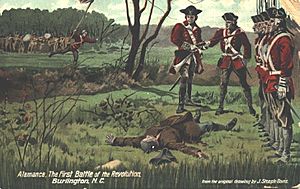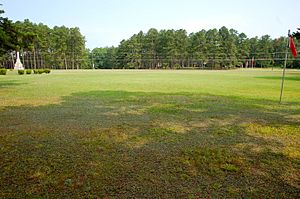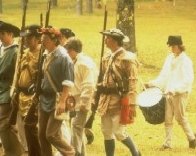Battle of Alamance facts for kids
Quick facts for kids Battle of Alamance |
|||||||
|---|---|---|---|---|---|---|---|
| Part of the Regulator Movement | |||||||
 "Alamance, The First Battle of the Revolution, Burlington, N.C." From the original drawing by J. Steeple Davis, written on a postcard, circa 1905-1915 |
|||||||
|
|||||||
| Belligerents | |||||||
| North Carolina Provincial Militia | North Carolina Regulators | ||||||
| Commanders and leaders | |||||||
| Royal Governor William Tryon | Herman Husband, Captain Montgomery, Captain Benjamin Merrill, others | ||||||
| Strength | |||||||
| appx. 1,000 | appx. 2,000 | ||||||
| Casualties and losses | |||||||
| Between 9 and 27 killed 61 wounded |
9 killed Unknown number injured 7 later executed for treason |
||||||
The Battle of Alamance happened on May 16, 1771. It was the last big fight of the Regulator Movement. This movement was a rebellion in colonial North Carolina. People were upset about taxes and how their local government was run.
Some people think this battle was the first spark of the American Revolution. The battle took its name from the nearby Great Alamance Creek. It happened in what was then Orange County, which is now Alamance County. This area is in the central Piedmont region, about 6 miles south of Burlington.
Contents
Why Did the Battle of Alamance Happen?
Some historians from the past thought this battle was a clear sign of the coming American War for Independence. People living at the time also felt this way. However, historians today have a different view.
They argue that the Regulators were not trying to completely overthrow the King's government. Instead, they were fighting against local officials who they believed were corrupt. The Regulators only used violence and rebellion as a last resort. They had tried peaceful ways, like petitions and elections, but nothing had worked to fix their problems.
It's interesting that many Regulators later supported the King during the American Revolution. Also, some who fought against the Regulators became American patriots.
How Did the Conflict Start?
In the spring of 1771, Royal Governor William Tryon left New Bern. He gathered about 1,000 militia troops. A militia is a group of citizens trained as soldiers. He marched them west to deal with a rebellion.
This rebellion had been growing in the western counties for several years. It started with small acts of violence. Then, people refused to pay fees and disrupted court meetings. They also bothered government officials.
About 2,000 "Regulators" had gathered. They hoped to scare the Governor into giving them what they wanted. They thought their large numbers would make him give in.
On May 11, Governor Tryon left Hillsborough with his militia. He was funded by a wealthy merchant named Samuel Cornell. They went to confront the Regulators. The Regulators had set up camp south of Great Alamance Creek.
What Happened During the Battle?
On the evening of May 15, Governor Tryon learned that the Regulators were camped about six miles away. The next morning, around 8:00 am, Tryon's troops marched to a field. This field was about half a mile from the Regulators' camp.
Tryon arranged his troops into two lines. He placed his cannons on the sides and in the middle of the first line. The Regulators, however, were not organized. They had no main leaders, only captains. They did not expect an attack. They believed their larger numbers would scare Tryon's militia away.
Governor Tryon's Warnings
Tryon sent one of his assistants, Captain Philemon Hawkins II, and the Sheriff of Orange County. They carried a message for the Regulators.
| Alamance Camp, Thursday, May 16, 1771.
To Those Who Style Themselves "Regulators": I have always cared about your county. I am sad that you have now forced me into this situation. You have turned away from the King and the laws. I ask you, Regulators, to put down your weapons quietly. Give up your leaders to the law. Trust in the government's kindness. If you agree to these terms within one hour, you will prevent bloodshed. Right now, you are rebelling against your King, your country, and its laws. (Signed) William Tryon. |
While this message was being read, Tryon's troops started to move forward. Soon after, Tryon was told that the Regulators had refused his terms. Herman Husband, a Quaker, realized that violence was about to begin. He left the area.
By midday, the hour given by Tryon had passed. Tryon sent one last warning message.
| Gentlemen and Regulators: Those of you who are not too deeply involved should stop and go home quietly. Those who have broken the law should surrender without fighting. I and others promise to get you the best possible terms. The Governor will not give you anything. You are not ready for war! You have no cannons! You have no military training! You have no commanding officers to lead you. You have no ammunition. You will be defeated! |
Some Regulators asked the Governor to exchange seven captured Regulators for two of his men they had captured. Tryon agreed. But after half an hour, his captured officers did not appear. Tryon became suspicious that his troops were being surrounded. He ordered his militia to march within 30 yards of the Regulators. Soon after, a large group of Regulators appeared. They waved their hats and dared the militia to shoot.
The Fighting Begins
Around this time, two men who were trying to make peace left Tryon's camp. They were Reverend David Caldwell and Robert Thompson. Caldwell reached the field between the two lines. But the Regulators warned him, seeing that the Governor was about to open fire. Thompson was held by Tryon as a prisoner.
In a moment of anger, Tryon took a musket from a soldier and shot Thompson dead. Realizing what he had done, he sent a flag bearer named Donald Malcolm with a white flag. He hoped to calm things down quickly. But the Regulators shot the flag bearer. They shouted, "Fire and be damned!"
The Regulators did not have the strong leadership, organization, or ammunition that Tryon's forces had. However, the battle started well for them. They fought in a style called "Indian style" fighting. This meant they hid behind trees and did not form straight lines. This allowed two Regulators, the McPherson brothers, to capture one of Tryon's three cannons. Unfortunately for them, the Regulators had no cannon ammunition, so they could not use it.
Captain Montgomery, a main military leader of the Regulators, was killed by a cannonball. At about the same time, a bullet hit Tryon's hat. The Governor sent a second white flag. But the assistant carrying it was killed. Regulator Patrick Muller called for his fellow fighters to stop shooting.
Governor Tryon was very angry that his second white flag was ignored. He rallied his troops against the Regulators. The Regulators were running out of ammunition. Many of them fled the field. About 300 reinforcements under Captain Benjamin Merrill did not arrive in time. Some Regulators stayed behind and kept firing at the militia. Tryon then ordered the woods to be set on fire.
Aftermath of the Battle
The exact number of dead and wounded on both sides is not clear. Tryon reported nine dead and 61 wounded among his militia. Other historians say the numbers were higher, between 15 and 27 killed. Both sides reported nine dead among the Regulators. The number of wounded Regulators ranged from dozens to about two hundred.
Tryon took 13 prisoners. One of them, James Few, was executed at the camp. Six others were executed later in nearby Hillsborough. Many Regulators moved to frontier areas outside North Carolina. The Royal Governor pardoned others. He allowed them to stay if they promised loyalty to the royal government.
The battle took place in what was then Orange County. Years later, during the American Revolution, this same area saw other small fights. This included the famous Pyle's Hacking Match in 1781. Recent studies at the site show that Alamance Battleground was also the location of another Revolutionary War skirmish. It was also a Confederate camp during the Civil War.
Who Fought in the Battle?
Colonial Militia Leaders
Governor Tryon's records show these men served under his command:
- Major-generals: John Ashe and Thomas Lloyd
- Lieutenant-generals: John Rutherford, Lewis Henry deRosset, John Sampson, Robert Palmer, Benjamin Heron, and Samuel Strudwick
- Majors of brigade: Abner Nash and Robert Howe
- Colonels: Alexander Osborne, Edmund Fanning, Robert Harris, James Sampson, Samuel Spencer, James Moore, and Maurice Moore
- Lieutenant-colonels: John Frohock, Moses Alexander, Alexander Lillington, John Gray, Samuel Benton, and Robert Schaw
- Majors: William Bullock, Walter Lindsay, Thomas Lloyd, Martin Fifer, and John Hinton
Some of these men later became important figures in the American Revolution:
- Alexander Lillington and James Moore were American patriots at the Battle of Moore's Creek Bridge.
- Richard Caswell was a delegate to the Continental Congress in Philadelphia. He helped write North Carolina's 1776 constitution. He was also the first governor of the new state.
- Francis Nash, whose actions helped start the Regulator Movement, fought and died as an American patriot in the Revolution.
- Griffith Rutherford served as a brigadier general in the North Carolina militia.
Regulator Members
These people were known as members of the Regulators:
- Herman Husband
- James Hunter – Called "General of the Regulators." His statue is now at Alamance Battleground.
- James Few – Executed at the camp after the battle.
- Charles Harrington – Died from wounds received in the battle.
- Abraham and John Helton
Governor Tryon did not pardon these individuals:
- Samuel Jones
- Joshua Teague
- Samuel Waggoner
- Simon Dunn Jr.
- Abraham Creson
- Benjamin Merrit [Merrill]
- James Wilkerson Sr.
- Edward Smith
- Malachi Fyke
- John Bumpass
- Joseph Boring
- William Rankin
- William Robeson
- John Winkler
- John Wilcox
Six men were found guilty of serious charges but were pardoned by Tryon:
- Forest Mercer
- James Stewart
- James Emerson – Later signed up as a Revolutionary War Patriot.
- Hermon (or Harmon) Cox – His powder horn is now on display at Alamance Battleground.
- William Brown
- James Copeland
Six men were found guilty of serious charges and were sentenced to be hanged:
- Benjamin Merrill
- Robert Matear (Matter)
- Pugh
- Captain Robert Messer
- Peter Craven
- One unknown man
Visiting the Battleground Today
Visitors can go to the Alamance Battleground State Historic Site. The battle site was first honored with a granite monument in 1880. A second monument was added in 1903.
Today, the site has exhibits, cannons from that time, and colored flags. These flags show where the troops were positioned. The visitors' center offers exhibits, old items, and a presentation about the battle. Visitors can also tour the Allen House, a restored farmstead from that period.
Reenactments and Pop Culture
The Battle of Alamance is remembered through an annual battle reenactment.
The battle also appears in popular culture. It is featured in the Diana Gabaldon novel, The Fiery Cross. It is also shown in the TV series Outlander. This happened in the fifth season episode "The Ballad of Roger Mac," which first aired in 2020.



